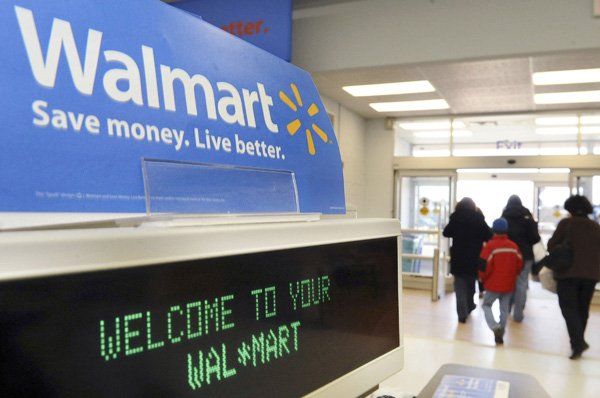WHY IT MATTERS: Results from Wal-Mart come as close as any retailer's can to being an economic indicator. Consumer spending, including major items like health care, accounts for 70 percent of U.S. economic activity. How quickly goods fly off the shelf at Wal-Mart provides a compelling checkup of the nation's economic health.
WHAT'S EXPECTED: Analysts surveyed by FactSet expect Wal-Mart to report earnings of $1.31 per share and sales of $117.52 billion for the quarter that ended in January.
LAST YEAR'S QUARTER: Wal-Mart earned $1.17 per share per share on sales of $112.83 billion, or $113.65 billion, including Sam's Club membership fees.
NEW YORK — Wal-Mart Stores Inc., the world's largest retailer, reports its fourth-quarter results before the market opens Tuesday.
WHAT TO WATCH FOR: Any signs of improvement in Wal-Mart's U.S. business.
Wal-Mart said it expects its holiday results to reverse six straight quarters of declines in revenue at stores open at least a year — a key measure of retailers' financial prospects — but not by a whole lot.
Wal-Mart issued a forecast in November for a range from a decline of 1 percent to a gain of 2 percent; it told reporters to focus on the midpoint. Analysts surveyed by Factset on average expect a 0.5 percent increase. Despite the declines, Wal-Mart has generally kept profits rising by relentlessly cutting costs and by growing internationally.
Wal-Mart's stock has slipped more than 3 percent since late January as Wall Street increasingly worries that the discounter's holiday season results will disappoint. The shares are now trading at $55, though that's still near the high end of their 52-week range of $47.77 and $57.90.
Missteps in merchandising and pricing have been big factors in Wal-Mart's weakness in U.S. sales. The company has resumed emphasizing low prices and stocking thousands of products it culled in a bid to clean up its stores. But these initiatives are "likely taking time to gain traction with shoppers," writes UBS analyst Neil Currie in a note published Feb. 10. Currie downgraded the stock to "Neutral" from "Buy."
"We don't think Wal-Mart had a great holiday season and, if anything, believe the (revenue) trend became sequentially worse as the quarter progressed," wrote Charles Grom, a retail analyst at J.P. Morgan in a report published last week. He said he expects unfavorable trends in traffic and market share of key consumables will persist in 2011, and he downgraded Wal-Mart's shares to "Neutral" from "Overweight."
Also putting the squeeze on Wal-Mart is increasing competition from dollar stores, grocery chains and Target Corp., which last October began giving customers who pay with its branded credit or debit card a 5 percent discount.
Analysts will want to know how new initiatives, including a recent collaboration with suppliers to offer products in smaller sizes it sells mostly for a dollar, are affecting customer traffic. They'll also want to know about inflationary pressures from soaring commodity prices and rising labor costs in China.
Wal-Mart is better able than smaller stores to control the prices it pays, but its main customers are the Americans most vulnerable to price increases because they live from paycheck to paycheck.
Rising gas prices, now over $3 per gallon nationally, also could push Wal-Mart customers trying to save on gas costs toward rivals like dollar stores that tend to be closer to home.

